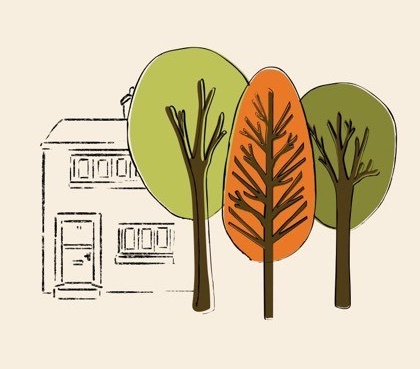The Cornmill: Difference between revisions
PhilRadford (talk | contribs) |
PhilRadford (talk | contribs) |
||
| Line 16: | Line 16: | ||
The locals tried long and hard to improve the quality of the soil bringing lime produced in the Yorkshire Dales and Lancashire by pack horse in an attempt to break down the clay structure of the soil. This traffic is recorded in the names of many routes across the moors, Limers Gate for example is a track across Midgley Moor passing the summit of High Brown Knoll. | The locals tried long and hard to improve the quality of the soil bringing lime produced in the Yorkshire Dales and Lancashire by pack horse in an attempt to break down the clay structure of the soil. This traffic is recorded in the names of many routes across the moors, Limers Gate for example is a track across Midgley Moor passing the summit of High Brown Knoll. | ||
The staple cereal of the Pennines was Oats, they were used to make a flatbread know locally as [https://traditional-yorkshire-recipes.info/ | The staple cereal of the Pennines was Oats, they were used to make a flatbread know locally as [https://traditional-yorkshire-recipes.info/havercakes/ | Havercakes] (derived the old Norse word for Oats, hafr). | ||
Fresh, these resemble a pancake but go hard and store well if left to dry. | Fresh, these resemble a pancake but go hard and store well if left to dry. | ||
Revision as of 15:26, 24 January 2025
THE EARLY HISTORY
The Luddenden Cornmills were owned by The Murgatroyd family for the majority of their life, the first record of a mill here was from 1274. There is a lot of published information about the early history of the mills including this: [Luddenden Mills]
Grinding Corn was the earliest record for the use of water power in the Luddenden Valley, but there were many uses for this valuable resource. The valley had at least eleven water mills with a range of uses.
Wheat, Oats and Barley but no Corn
A Cornmill didn't actually grind Corn, well not Corn as we know it today as the word Corn is now used mainly to describe Maize. Historically Corn referred to all Cereal crops.
Here in the Pennines, the main cereal crop would have been Oats. Today when we think of Oats, we think of Scotland!.
Oats grow better than wheat in our cooler, wetter climate and heavy Pennine soil.
The locals tried long and hard to improve the quality of the soil bringing lime produced in the Yorkshire Dales and Lancashire by pack horse in an attempt to break down the clay structure of the soil. This traffic is recorded in the names of many routes across the moors, Limers Gate for example is a track across Midgley Moor passing the summit of High Brown Knoll.
The staple cereal of the Pennines was Oats, they were used to make a flatbread know locally as | Havercakes (derived the old Norse word for Oats, hafr). Fresh, these resemble a pancake but go hard and store well if left to dry.
Stew and hard was a local delicacy, a Havercake snapped in half with a slice of cold gelatinous cow heal stew as a filling.
Census records from the mid 1800's show many ladies in the village were producing these to sell.
The Demise of The Cornmills
Industrialisation brought people to the valley, more than the local farmers could feed.
The Cornmills which were originally owned by the Lord of the Manor gradually slipped away from manorial control and new entrepreneurs took them over.
The improvement in the country's infrastructure and the arrival of steam power meant that wheat grown in more fertile soils could be cheaply transported into the Pennines in bulk and did not need water power to drive the millstones.
The mills now needed to be close to canals and railways not close to streams and rivers. And as their output was no longer restrained by the quantity of water available, the mills could be bigger and became more centralised.
The trend continued, pushing the mills to ports like Hull, Liverpool and Manchester (thanks to the ship canal) as imported wheat became readily available.
This regionalisation, with areas of the country being dominant in one particular skill and dependant on other specialist hubs for the items they lacked has gown and now crosses national boundaries to become a global phenomenom!
The Pennine farmers no longer struggled to try and grow cereals and swapped to struggling to make a living out of cattle farming instead!
And the old mills closed, eventually demolished with a few lucky survivors being converted into apartments!!
THE CORNMILL AFTER 1854
The Last Days of Murgatroyd Control
The last Murgatroyds to run the mills were brothers Hartley (1797-1865) and John (1799-1873).
The brother's seem to have got into some financial difficulties and had to sell a lot of property in Luddenden and the surrounding valley including the Cornmills.
Twenty lots were put up for auction at the Murgatroyd Arms on 19th July 1854. Neither of the Mills sold on the day, but both change hands shortly afterwards.
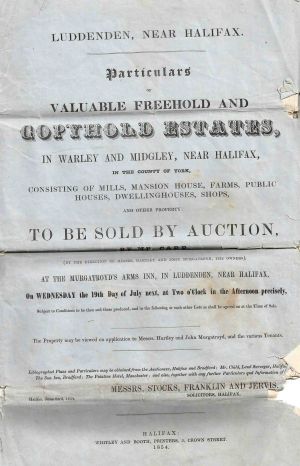
The brochure for the auction included two maps, the first showed the lots for sale on the hills surrounding the village.
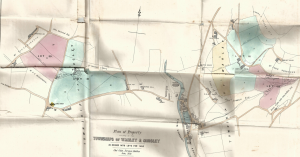
The second map shows the village lots.
On this second map, Lot 13 is Upper mill and includes the mill pond and a plot of land and sluices next to the weir. The land that the mill occupied is now housing (High Street Court).
The map shows the function of each of the buildings in the mill. The majority of the mill was being used for malting barley ready for making beer.
An accompanying document also describes the property;
All that valuable Corn Mill called "Upper Mill" situate in Luddenden, with the Malt Kiln, Warehouses, Stabling for 18 Horses, Wagon and Cart sheds, Gighouse, Joiner's Shop, Paved Yards and Outbuildings. Also the Reservoir behind the same, containing 2,008 superficial square yards, with the Water Wheel and the entire Fall of the Luddenden Brook, being about 30 horsepower. And also the Weir and Dam-stones across the Brook, Cloughs, and the Plot of Ground appropriate thereto, together with the use of the head Goit and the Tail Goits.' 'The Mill is five stories High, and attic, and the whole of the premises have been recently rearranged. The water wheel is a new iron one, 27 feet in diameter and nine on the breast.
The wheel generated about 30 horsepower.
Lot 14 is Lower mill. The three stoery building now know as The Cornmill is the only surviving part of the mill shown on this map. The two storey part of today's Cornmill was a later addition (but built before 1890).
On the map, you can see the head and tail goits that fed the water wheel. You can see that there is a boiler room and a chimney (so this mill had steam power at this date). There are cottages to the south side of the mill and a building labelled as Counting House adjacent to the bridge.
The land of Lot 14 is labelled as 'Holme' and it extends as far as the next weir on the brook. This whole area is now occupied by Blue Bell Walk. The field above Lower Mill, Lot 15 is labelled as 'Bank'. The Eastwood family bought both Lot 14 and 15 in about 1856 and immediately started to convert and extend this mill into a sizable woollen mill.
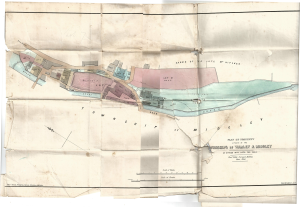
Below is a copy of the previous map, highlighting Lot 13. This hand traced copy is part of a document drawn up in 1856 when Upper Mill was sold by Hartley and John Murgatroyd to the Thompsons and their partner, Joseph Starkey (who bought a third share in the mill).
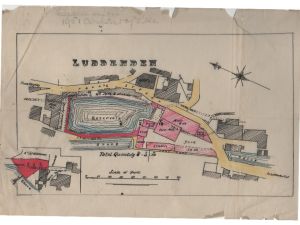
The Thompson Family at Upper Mill
In 1856, Upper Mill was Sold to:
- George Thompson (b.1786), one third share.
- Joseph Starkey, one third share.
- Robert Thompson (1810-1875), one sixth share.
- William Henry Thompson (b.1817), one sixth share.
Robert and William Henry Thompson were brothers.
George Thompson (b.1786), their father had an established Corn Milling business and already owned one of the Mills at Luddendenfoot. He was living at Middle foot in 1841.
Robert Thompson (1810-1875)
Robert Thompson was baptised at a Methodist Chapel in Luddenden on 13th August 1810. He was living at Upper Foot (this is the area around Burnley Road heading towards Brierley) in 1851 working as a Corn Miller. After the purchase of Upper Mill, George and his family moved into Chapel House (another Purchase in the 1854 Auction), the house that John Murgatroyd had lived in. At this stage he is employing 2 men according to the 1861 census.
In 1863, Robert bought William Henry's Share in the mill for £1000 (to become the sole owner of Upper Mill?)
By 1871, Robert and his family had moved to Carrfield (which was built for them?) and he is employing 11 men at Upper Mill.
Robert dies in 1875 aged 65, his wife took ownership of the business which their son Arthur ran. The business continues to grow and in 1881 it employed 22 men and 2 boys.
But then, the family suffers some set backs, both Robert and Hannah's sons died. Arthur died in 1899 and his younger brother George had died in 1882. George's only son Frederick William also died in 1894.
All of this is recorded on the family memorial in Luddenden Cemetery, the monument, a tall obelisk with a pink granite top is easily located and is situated to the north side of the chapel of rest.
This left the family with a big problem as there re no males left to succeed Arthur, the Upper Mill being inherited by Robert's two daughters, Mary and Julia.
Whether through a fall in demand for milled oats and wheat or through a lack of leadership, the mill ceased to produce flour in the early 1890's and the Thompson sisters start to rent out sections of Upper Mill to people starting up new business ventures or for businesses requiring additional space for expansion. So the site becomes an industrial estate.
William Henry Thompson (b.1817)
Meanwhile William Henry moves into Cooper House (in 1861 census) and then to Stansfield Hall (John Naylor Lane, Luddendenfoot).
He continues to be a Corn Miller after selling his share in Upper Mill. He focuses his efforts on his own Cornmill at Luddendenfoot. This may have been Denholme Mill (on the south side of Burnley Road heading towards Cooperfield overlooking the canal) or may have been on Luddendenbrook near The Weaver's pub.
Historically, there were two fulling mills at Luddendenfoot one on either side of Luddenden Brook, one was where The Weaver's pub is situated and one directly opposite on land now occupied by Mill Stream Drive. These may also have been Cornmills at some stage during their history.
The 1871 census shows that he is employing 16 men and 2 boys.

These invoices remind us that the staple crop in the Pennines was Oats, not wheat, the bulk of these two orders being oatmeal but what did the Cornmill produce?
